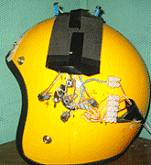THE GOD HELMET
Todd Murphy, 2007
 | The God Helmet is the popular name given to a laboratory apparatus more correctly called the "Koren Helmet", after Stanley Koren of Laurentian University's Neuroscience Department, who built it according to specifications provided by Dr. M.A. Persinger, director. The Koren Helmet applies complex (having an irregular shape) magnetic signals to the head of the person who is wearing it. The Koren Helmet is connected to a PC computer through a 'black box' which cycles the signals through four coils on each side of the head over the temporal lobes of the brain. The temporal lobes are the area of the brain many researchers feel is the source of spiritual and religious experiences. link | |||||
 | This illustration shows how the signal shifts from one coil to the next. This is a side view. There is also another set of coils working on the other side. The two coils at the top are no longer used. The sessions are done in an Acoustic Chamber - a completely silent room. A large part of the temporal lobes ongoing activity is dedicated to monitoring ambient sound. The temporal lobes are the source of religious and mystic experiences, so that silence helps a great deal in creating these experiences in the lab. | |||||
| Used as a research tool to investigate the bran's role in religious and mystic experiences, the Koren Helmet has been given the name God Helmet. A few Journalists gave it this name when they learned that some people had visions of God while participating in Koren Helmet experiments. The name has stuck. I asked Dr. Persinger how many people had seen God using the Koren Helmet, and this is what he said in reply:
| ||||||
 | There is much more to the God Helmet than just the Koren Helmet alone. There is also a computer program called complex, authored by Stanley Koren, which allows the computer to create the signals. These signals are derived from EEG traces that appear in certain parts of the brain. Just as the brain responds to chemicals with specific shapes, it also responds to magnetic signals with certain shapes. Because these signals are complex, irregular things, it takes a special computer program to produce them. A third component is the acoustic - completely silent - chamber where the sessions take place. The last component is the 'black box' which converts output from the computer into input for the Koren Helmet. This box (not shown) is a specialized DAC (digital-to-analog converter). It's the core of the technology. The rest of the components of the God helmet are quite common. |
The God Helmet is a misleading name. It give the impression that it can produce the experience of God. In fact, only one percent of the subjects had the experience. It also passes over the crucial role of sensory deprivation - above all, the completely silent environment provided for the subjects. In contrast to the one percent who saw God, 80% of the subjects felt a presence of some kind, but did not call it God. Of course, there were probably some subjects who experienced an appearance of God, but were shy about saying they had seen God in a laboratory. That kind of thing is not only intensely personal, but can also get you ridiculed. If you saw god, would you tell your story just as it happened if you thought you weren't going to be taken seriously? A lot of people assume that, just because someone wears a lab coat, they won't believe such a vision can happen, or that it's a sign of a mental illness. Nothing could be further from the truth in this laboratory, but how would these subjects know that? They had been told they would be participating in an experiment to study relaxation response, and the experimenters were very careful not to encourage such glamorous reports.
| ||||||
 | A somewhat blurry picture of the sign on the door to the laboratory. The present author is second from the top on the right. Dr. M.A. Persinger is fourth from the top on the left. Stan Koren is third from the bottom on the left. The Koren Helmet uses a snowmobile helmet to hold the coils in place. |


